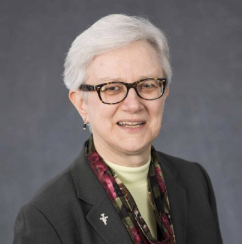

Readings:
Proverbs 8:22-31
Romans 5:1-5
John 16:12-15
Trinity: The Living God of Love
That God is The Holy Trinity, Father, Son, and Holy Spirit is a central claim of Christian faith. This assertion is difficult to put into everyday language! Fully knowing God is beyond human comprehension. God is a mystery to people. Yet, being a Christian requires that we live in community with others, and doing that with an understanding of who God is, and what God requires of us.
Today’s scripture readings each illustrate key experiences of God, as Trinity. Proverbs images divine Wisdom as a Woman. St. Paul focuses on God’s work of salvation, emphasizing God’s love experienced in Christ’s glorification, and the Spirit’s continuing presence. Jesus describes how the Spirit’s presence continues to reveal the Father in Jesus’ absence.
“Trinity” cannot be explained, if understand literally. That was never the intent of trinitarian belief. God is ultimately a Mystery. We can only speak of Trinity in a descriptive sense. Indeed, “the Trinity” is a way of describing what we know about God. Christians speak from our experience of God, while knowing that God is beyond our reason. Experientially, we do know and can speak about God as Trinity.
First, to understand the impact of naming God as Trinity, we must link our experience of God with that of the first Christians. This text, 2 Cor.13:13, dates back to about 55-56 CE, and shows what first Christians understood from their experience: “The grace of the Lord Jesus Christ and the love of God and the fellowship of the holy Spirit be with all of you.”
Trinitarian speech about God arose in the Christian community because people encountered God’s saving graciousness through Jesus Christ in the power of the Spirit. The specific encounter that spurred that development was encountering Jesus Christ, whose life, death, and risen presence in the Spirit was made tangible, through God’s gracious mercy, poured out in daily life, amid sin and suffering. In order for Christians to describe and witness to others about God, they tried to codify language that best described their experiences.
However, the First Century Christians were Jewish monotheists, people who believed in One God. As theologian, Elizabeth A. Johnson explains: “The utterly transcendent God of Israel – Creator and Redeemer had drawn utterly near to them in Jesus, and had become amazingly enfleshed and was with them still in the Spirit, who inspired the gifts in their community.” They experienced the saving God in a three-fold way: Beyond them, with them, and within them. In personally knowing Jesus, God was utterly transcendent, as present historically in the person of Jesus, and as present in the spirit of their community. The early Christians experienced this as moments of encounter with the One God, and so they began to talk about the One God in that three-fold pattern (Cor. 13:13).
Over the centuries Christians tried to explain an unexplainable experience in philosophical terms: 4th C. – Egyptian priest Arius; 325 CE – Council of Nicaea; 381 CE – Council of Constantinople. Those models often obscured the initial and ongoing faith experience of the Faithful. Scripture scholar, Sandra Schneiders mused, “God is not two men and a bird!” Nor, according to theologian Catherine Mowry LaCugna, is it orthodox to name the Trinity in exclusively masculine terms, because God is a Spirit.
Again, the intent of the Trinitarian symbol is to acclaim the God who saves and to lead us into this mystery of Love. This is rooted in: the Experience of Salvation: God is Creator, Source of all; God enfleshed in Jesus Christ-Word, Wisdom, Son; Holy Spirit God is gifting presence, love, drawing all thing into the future.
To name an incomprehensible Mystery can be done only by analogy. As St. Augustine wrote:
But you still ask, “three what?” Now the poverty from which our language suffers becomes apparent. But the formula of “three persons” was coined not in order to give a complete explanation by means of it, but in order that we might not be obliged to stay silent. On the Trinity, 5.10
Elizabeth A. Johnson summarizes: “The numbers one and three do not refer to numbers in the usual sense….To say the God is ONE is to negate division, thus affirming the unity of the Divine Being; there is only ONE God. To say the “persons” are THREE is to negate solitariness, thus affirming the divine being dwells in living communion. The holy Mystery of God is not a single monolith with a rigid nature, an undifferentiated whole, but a living fecundity of relational life that overflows to the world. Most basically, the numbers point to the livingness of God.” How do you experience and name God?
Dawn M. Nothwehr, OSF, Ph.D.
The Erica and Harry John Family Professor Emerita
of Catholic Theological Ethics